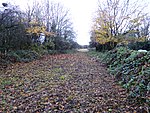A563 road
Geographic coordinate listsInfobox road instances in the United KingdomInfobox road maps tracking categoryLists of coordinatesRing roads in the United Kingdom ... and 5 more
Roads in EnglandTransport in LeicesterTransport in LeicestershireUse British English from January 2013Vague or ambiguous time from May 2017

The A563 is the designation for the ring road of Leicester, England. It forms a near-complete circuit except for a gap of around 2.2 miles (3.5 km) in the east of the city. An indirect route linking the gap involves the (A47) A6030, and A6. The A563 was formerly referred to as the Outer Ring. If the outstanding section were completed, the road would have a circumference of about 19 miles (31 km) and an average distance from Town Hall Square of around 3 miles (4.8 km).
Excerpt from the Wikipedia article A563 road (License: CC BY-SA 3.0, Authors, Images).A563 road
New Parks Way, Leicester New Parks
Geographical coordinates (GPS) Address Nearby Places Show on map
Geographical coordinates (GPS)
| Latitude | Longitude |
|---|---|
| N 52.6448 ° | E -1.1815 ° |
Address
New Parks Way
New Parks Way
LE3 6QF Leicester, New Parks
England, United Kingdom
Open on Google Maps






